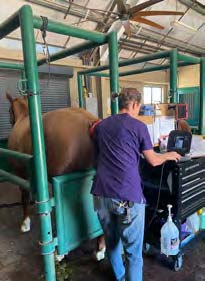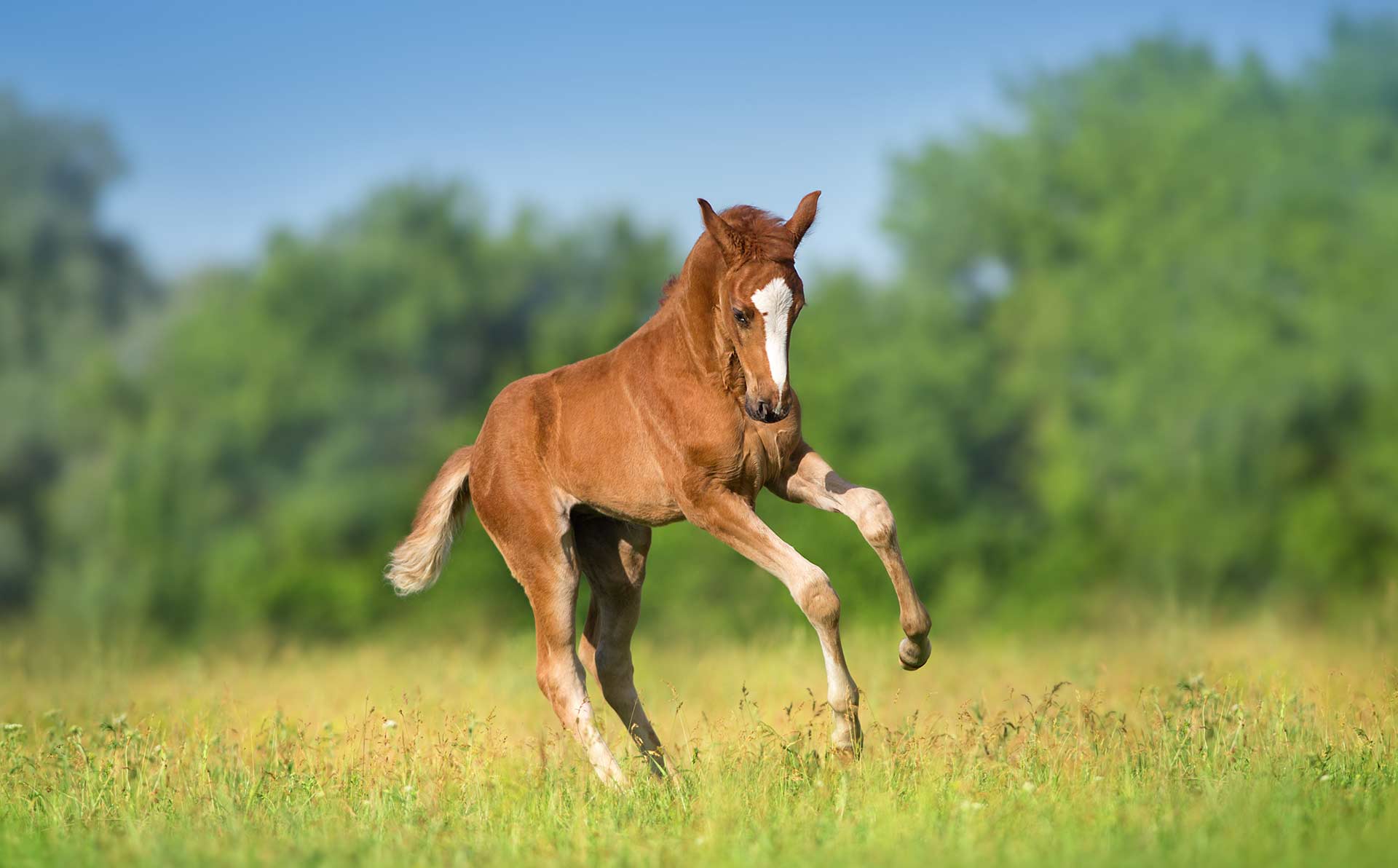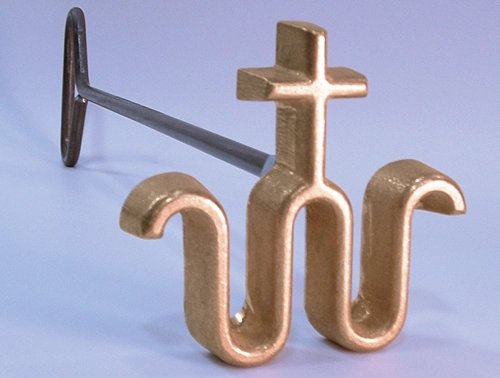Newborn foals can be exciting, fun, and enjoyable. You may have a beautiful mare you have competed on, worked cattle with, or personal riding horse and you want another one like her. There are plenty of motivations for breeding a mare. Make no mistake, though, there are many factors to consider before diving into the breeding process.
Does breeding your mare make sense? Determine if the mare is a good breeding candidate. Some major considerations are physical conformation, disposition, and age. While no horse is perfect, you should consider all your mare’s faults and weaknesses. This will also help you when choosing the right stallion. Do your research and choose a stallion that will not double up on your mare’s faults and weaknesses.
Stud fees can range from $250 to over $25,000. Investing in the best stallion genetics that is realistic for your budget is necessary. If planning to cut corners with the stud fee, rethink if breeding your mare is the right choice. To quote a thoroughbred breeders’ mantra, “Breed the best you have with the best that you can afford.” Regardless of whether you choose artificial insemination (AI) with “cooled shipped semen”, “frozen semen” or “live cover,” you will be responsible for a booking fee (ranging from $100- $800) to reserve your spot in line for the stallion’s services in the upcoming breeding season. Read your contracts thoroughly. If “frozen semen” is the only option for breeding to the stallion you have chosen make sure you ask your veterinarian if they are proficient in breeding with frozen semen before you sign and pay for the contract.
 Veterinarian costs for breeding your mare will become THE TRUE COST FOR YOU. There is no use in breeding mares with poor conformation and a bad attitude — you’ll get more horses with poor confirmation and a bad attitude. Also, breeding maiden (never been pregnant) mares, can be more expensive with failure to conceive. Have you considered the long-term commitment of breeding and having a foal to feed for years to come? Are you planning on selling the foal after it is weaned? Do you have the time to halter train the foal and/or train it to ride?
Veterinarian costs for breeding your mare will become THE TRUE COST FOR YOU. There is no use in breeding mares with poor conformation and a bad attitude — you’ll get more horses with poor confirmation and a bad attitude. Also, breeding maiden (never been pregnant) mares, can be more expensive with failure to conceive. Have you considered the long-term commitment of breeding and having a foal to feed for years to come? Are you planning on selling the foal after it is weaned? Do you have the time to halter train the foal and/or train it to ride?
If you will have extra money to care for the mare and foal, any potential post foaling complications and the ability to commit the necessary time for the next several years then it’s time to consider the cost of breeding your mare. The one-time stud fee for the stallion you have chosen is the first part. Breeding your mare until it has a positive pregnancy and heartbeat costs vary. Here is a list of other costs to consider, prices will vary depending on your location and veterinarian.
- Prior to breeding your mare, she must be current on all vaccines as your mare will not be vaccinated again until 10 months of gestation. ($50-$100)
- It is recommended that your mare has a Pre-Breeding ultrasound. For mares who have never been bred, doing so will provide you with the necessary information about their reproductive tract and tell you if they are a good candidate for breeding. We recommend doing this prior to buying your stud fee.
- An experienced reproductive veterinarian will monitor your mares’ cycle closely to determine follicle size and timing of breeding to stallion. When the mare follicle size is getting closer to breeding and ultrasound daily is to be expected. ($50 – $100 per ultrasound)
 Shipped Cooled Semen is sent via Fed-Ex and/or counter to counter via airline carrier. The cost of transporting the semen is your responsibility and the stallion owner/station will charge you for this. Most veterinarians try to use Fed-Ex shipping due to the ease delivery of package to their office and the lower cost to the client. However, if your mare changes quickly and there is fear the semen won’t arrive before ovulation than counter to counter via airline carrier is necessary. (Collection with Fed-Ex Shipping $300+, Collection with Airline Shipping $400+) These fees are just guidelines. All fees are generally written in you stallion breeding contract. If they are not listed, ask before you sign.
Shipped Cooled Semen is sent via Fed-Ex and/or counter to counter via airline carrier. The cost of transporting the semen is your responsibility and the stallion owner/station will charge you for this. Most veterinarians try to use Fed-Ex shipping due to the ease delivery of package to their office and the lower cost to the client. However, if your mare changes quickly and there is fear the semen won’t arrive before ovulation than counter to counter via airline carrier is necessary. (Collection with Fed-Ex Shipping $300+, Collection with Airline Shipping $400+) These fees are just guidelines. All fees are generally written in you stallion breeding contract. If they are not listed, ask before you sign.- Alternatively, frozen semen is an option. Ask your veterinarian if they can breed your mare with frozen semen and to explain how the process differs. The cost of breeding with frozen semen are much higher due to the labor-intensive process for the veterinarian.
If your mare does not become pregnant after the first cycle, it does not necessarily mean there is a problem unless there is specific evidence to support it. However, if a mare does not become pregnant after two or three cycles, it is important to consider all factors as to why she is not getting bred.
- Prior to insemination, your mare must be current on all vaccinations ($0-$50), and it is recommended she have a reproductive tract exam and uterine culture done to confirm health (~$200).
- A good reproductive veterinarian will need to closely monitor your mare’s ovarian cycle via ultrasound ($50-$100 per visit) for a number of days prior to AI. This is necessary to determine when to have the semen collected ($100-$150), shipped overnight ($75-$200 depending on destination), and plan the most effective time to inseminate ($95+).
- Are willing to pay board (roughly $18 to $25 per day for up to two weeks depending on how quickly she ovulates).
- Any hormones used in the process of getting your mare to cycle should be considered ($100-$150).
 At least one to two visits to the vet, post breeding at 14 days to confirm pregnancy and one at 30 days to confirm via ultrasound a heartbeat and successful ongoing pregnancy ($50 – $100 per visit).
At least one to two visits to the vet, post breeding at 14 days to confirm pregnancy and one at 30 days to confirm via ultrasound a heartbeat and successful ongoing pregnancy ($50 – $100 per visit).- If your mare does not become pregnant after the first cycle, can you spend the money to try again? It does not necessarily mean there is a problem unless there is specific evidence to support it. However, if a mare does not become pregnant after two or three cycles, it is important to consider all factors as to why she is not getting bred and decide if you are willing to pay for cultures ($200+) to determine if your mare has an underlining uterine infection.
 Your mare is confirmed pregnant at 14 days and a heartbeat is confirmed at 30. Generally, after the heartbeat ultrasound exam veterinarians will not see you again until months 5, 7, and 9, when it is strongly recommended that the mare receive a dose of a Pneumobort HSV-1 booster vaccine. This vaccine boosts the mare’s immune system and helps prevent rhinoneumonitis, which can lead to abortion.
Your mare is confirmed pregnant at 14 days and a heartbeat is confirmed at 30. Generally, after the heartbeat ultrasound exam veterinarians will not see you again until months 5, 7, and 9, when it is strongly recommended that the mare receive a dose of a Pneumobort HSV-1 booster vaccine. This vaccine boosts the mare’s immune system and helps prevent rhinoneumonitis, which can lead to abortion.
 If all goes according to plan, in approximately 340 days (11 months) the new foal will be born. Following delivery, your veterinarian should perform a wellness exam on the mare and the foal. Even if both appear healthy, it is important to confirm the mare was able to pass the placenta, the foal is adequately nursing and has received the necessary colostrum to thrive. (IgG blood test $50). The exam will also ensure the foal doesn’t show any signs of limb abnormalities or infections. Another relatively common and potentially life-threatening complication following parturition is “broodmare colic.” With the uterine contractions and sudden internal absence of the foal, torsion of the mare’s colon and intestine is possible. Monitor mares for colic symptoms following foaling. Any of these complications have the potential to significantly increase the costs of your breeding venture. Besides the foaling process, there are a few additional costs to consider.
If all goes according to plan, in approximately 340 days (11 months) the new foal will be born. Following delivery, your veterinarian should perform a wellness exam on the mare and the foal. Even if both appear healthy, it is important to confirm the mare was able to pass the placenta, the foal is adequately nursing and has received the necessary colostrum to thrive. (IgG blood test $50). The exam will also ensure the foal doesn’t show any signs of limb abnormalities or infections. Another relatively common and potentially life-threatening complication following parturition is “broodmare colic.” With the uterine contractions and sudden internal absence of the foal, torsion of the mare’s colon and intestine is possible. Monitor mares for colic symptoms following foaling. Any of these complications have the potential to significantly increase the costs of your breeding venture. Besides the foaling process, there are a few additional costs to consider.
If the foal is a colt, he will probably be gelded, ideally within the first year of his life ($300). It is also a common practice to vaccinate the foal at 3 months of age ($100 for miscellaneous vaccines). If you plan to register the foal with a breed association such as the American Quarter Horse Association, those costs should be included as well ($50-$150).
The Bottom Line… having a mare bred requires serious investment of money, time, and mental toughness. If considering breeding your mare, make the responsible decision of whether your mare is a suitable candidate and if you have the disposable income and time to do it right. On the other hand, if you believe your mare is a good breeding candidate and you are prepared for the challenge, then we truly wish you luck, enjoyment, and success!
By: Dr. Alicia Lindholm







